Psychophysiology and Emotions in Games User Research
- March 18, 2024
- Try Evidence Research Team
As a game developer or publisher, you probably know that emotions are key to player experience. They impact how players perceive games, what motivates them, and how they behave. Emotions also help players remember the game and the experience. Therefore, they play a vital role in whether players will purchase the game. With 14,531 games released on Steam in 2023, it’s more important than ever to evoke emotions in players. Your ability to do so can make or break your game. So, how can you be sure that your game, teaser, trailer, or gameplay movie will win the crowd? That’s where psychophysiology comes in.
You may do it the traditional way…
Games user researchers commonly use observation, surveys, and interviews to evaluate players’ emotions. However, these methods have both advantages and drawbacks.
Surveys and interviews help obtain feedback on a player’s experiences, but they rely on the player’s memory. This can result in recall bias and lost information due to forgetting. Additionally, responses can be biased due to recency bias. This is a player tendency to remember their experiences better towards the end of the gameplay session rather than at the beginning. Administering surveys or interviews during gameplay can minimize this bias but may interfere with the player’s natural behavior.
Another major methodological issue is bias in self-reported data, such as social desirability bias. Respondents usually provide answers they believe are more acceptable to present themselves better. Participant engagement is another concern, as fatigue or lack of interest can result in incomplete or unreliable responses. Players may sometimes misattribute the cause of an emotion, incorrectly identifying its source. They might also generalize the emotion to the entire experience, rather than isolating it to the specific element that triggered it.
To understand a particular subject, it is best to use information gathered from various sources. This approach not only provides diverse perspectives but also strengthens the credibility and reliability of the research findings. Therefore, it is advantageous to supplement subjective methods, focusing on players’ conscious attitudes, with more objective psychophysiological measures.
… but it might be better to use the psychophysiological way
Psychophysiology is a field that explores the complex workings of the human mind. It does so by measuring physiological signals such as skin conductance, muscle activity, brainwaves, and heart rhythm. These methods provide insights into psychological processes that were previously beyond reach.
These signals are spontaneous, involuntary, and difficult to fake, which makes them incredibly reliable and unbiased sources of information.
The research psychologist can access this data in real-time throughout the gameplay session, eliminating any reliance on the player’s memory. This technology allows us to capture signals as they occur, with minimal interference in the player’s natural behavior. Its high precision allows it to detect even the smallest responses, far beyond the capability of the human eye. This makes it more accurate than traditional observation in certain specific use cases. Leveraging psychophysiology, we’re reaching new levels of precision and insight into how players react to games.
However, these measures have limitations. Directly mapping a psychological state to a physiological effect is impossible, as one physiological response may be associated with many psychological states.
For example, a faster heartbeat and clammy hands might signal the body’s reaction to something frightening—or to seeing someone attractive. It’s important to note, however, that no psychophysiological method currently enables researchers to read players’ minds. While physiological measurements offer valuable insights into players’ psychological states, researchers must interpret these signals indirectly. For this reason, physiological data should be analyzed within context by trained researchers with expertise in psychology. Ideally, this analysis is supplemented with follow-up interviews or surveys to gain deeper insights.
First, know how we measure emotions in modern psychology
Russell’s circumplex model of affect is a key framework in psychophysiology for understanding emotions. The model maps emotions along two main dimensions: valence and arousal. Valence represents the emotional direction, showing whether an emotion is positive or negative. Arousal, or excitement, on the other hand, measures the intensity of the emotion, ranging from high to low. This interaction between valence and arousal allows for a nuanced view of emotions.
For instance, both anger and sadness have a negative valence, yet they differ in arousal—anger is high-arousal, while sadness is low-arousal.
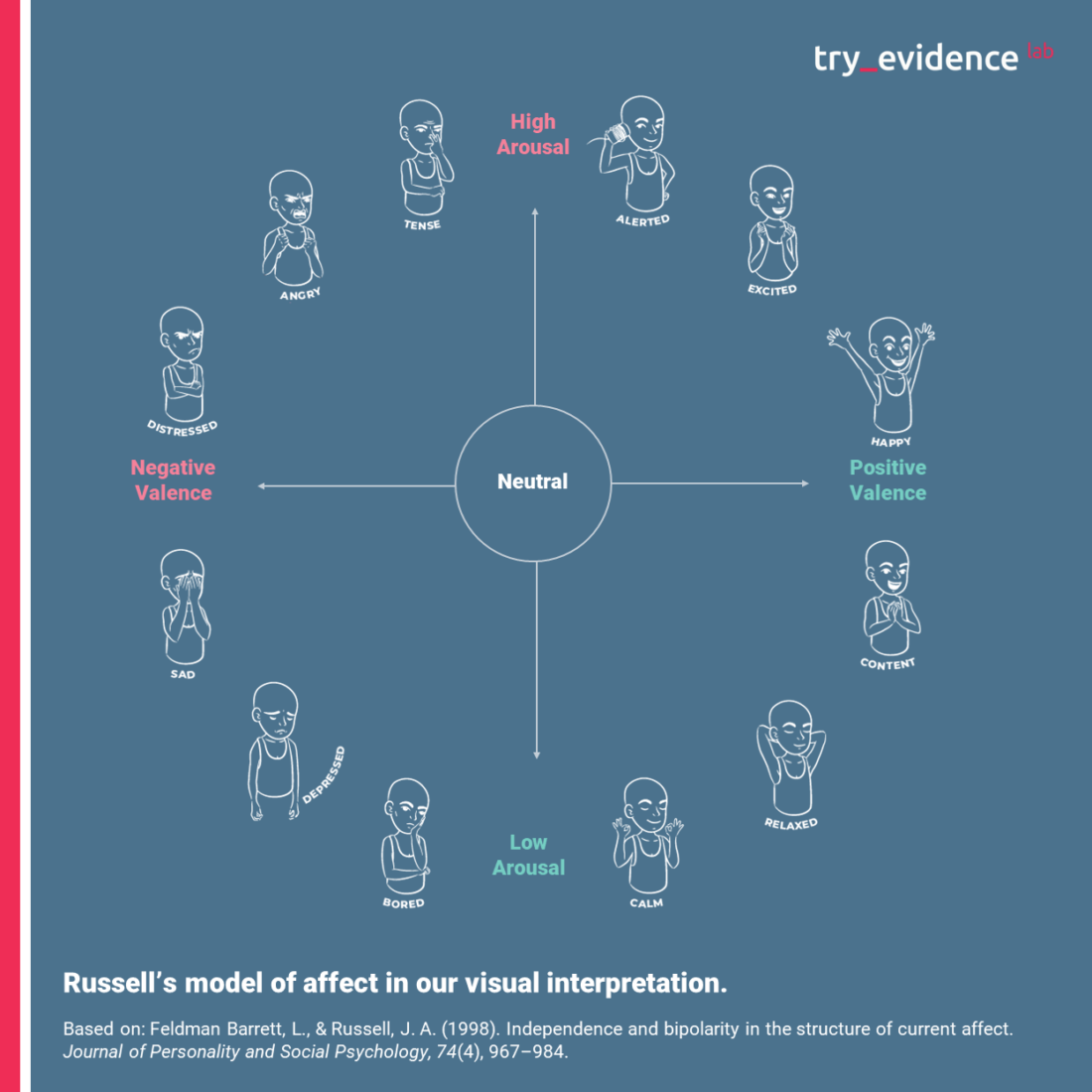
Russell’s model is popular in psychophysiological research because it addresses the limitations of physiological responses in pinpointing specific emotions. Although psychophysiological instruments cannot directly identify discrete emotions, they can measure signals related to valence and arousal. From these measurements, researchers can infer the emotional states of individuals.
With this foundation, we can now explore how the model interprets bodily signals to better understand emotional experiences.
Second, understand how emotions translate to psychophysiology
Given the scope of this article, we will provide a brief overview of the most commonly used types of measurements in psychophysiology.
Electromyography (EMG)
As previously highlighted, most physiological signals are linked to just one of the two emotional dimensions—valence or arousal. Among the various methods for measuring valence, electromyography (EMG) stands out as one of the most commonly used.
In simple terms, EMG works by detecting electrical signals generated during muscle contractions. When a muscle contracts, it produces electrical activity, which EMG can measure. In Games User Research (GUR), valence is typically studied through facial EMG, which assesses the activation of specific muscles tied to emotional expressions.
For instance, brow muscle activation is linked to negative valence, as these muscles are engaged when a person frowns, which commonly occurs in response to emotions such as anger, frustration, or sadness.
On the other hand, the activation of muscles around the lower eyelid and cheek is associated with positive valence, as they are involved in smiling, which often signals happiness, joy, or contentment.
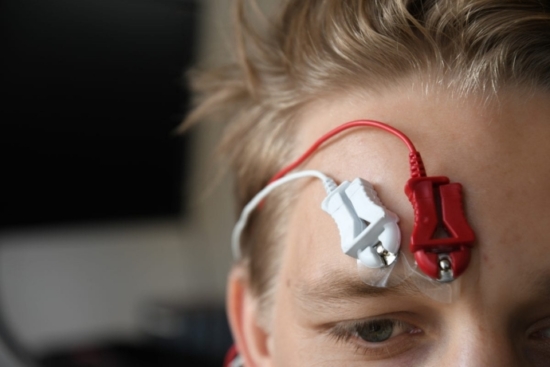
EMG’s Advantages and Shortcomings in Psychophysiology
One of the significant advantages of EMG is its sensitivity. It can detect even the smallest facial muscle movements, often invisible to the naked eye. This sensitivity allows researchers to capture subtle facial expressions that might otherwise go unnoticed. However, this sensitivity is also a double-edged sword. While it allows for the detection of small muscle contractions, EMG electrodes can also pick up activity from nearby, unintended muscles, which may introduce noise into the data. This makes it challenging to isolateand measure the specific emotional response.
As a result, participants must remain still and avoid actions like talking, laughing, or chewing during the measurement, as these movements can interfere with the data and make it unreliable.
This requirement can be particularly uncomfortable during extended gameplay sessions, where natural movements and expressions are difficult to suppress.
Moreover, using facial EMG requires placing electrodes on the participant’s face, which some may find intrusive or uncomfortable. The process of electrode placement also requires precision, as accurate positioning is critical for measuring the right muscles. In non-clinical settings, such as in a gaming environment, achieving this precision can be challenging, and any deviation from the ideal electrode placement can lead to inaccurate readings.
Respiration
Respiration offers several types of data that can indicate emotional arousal, helpful in the field of psychophysiology. Key metrics include respiratory rate, variability, breath depth, and even sigh rate.
Respiratory Rate
Respiratory rate refers to the frequency of breathing. Typically, a faster respiration rate correlates with high arousal, indicating a heightened emotional response such as excitement or stress.
Conversely, a slower respiratory rate typically links to the activation of the parasympathetic nervous system (PNS), which promotes calm and relaxation. The PNS reduces physiological arousal by lowering heart rate and muscle tension. This creates a state of tranquility and diminishes emotional intensity. As a result, slower breathing is commonly associated with calming effects and reduced arousal.
Respiratory Variability
However, emotional arousal is not always captured by the rate alone; it can also be seen in respiratory variability. This variability appears as irregular breathing patterns, sudden changes in breath rate, or brief pauses in breathing. Such occurrences are common during intense emotional experiences. For instance, negative emotions like fear and anxiety are associated with both increased respiratory rates and greater variability, particularly in expiratory time. This indicates that the body’s response to fear involves intricate changes in both the rhythm and depth of breathing. Additionally, respiratory variability can also be an indicator of cognitive load. Research shows that fluctuations in respiratory patterns are sensitive to cognitive demands, which emotional states can influence. This suggests that respiration not only reflects emotional arousal but also provides insight into cognitive engagement.
When it comes to breath depth, deeper breathing is often linked to positive emotional states. In contrast, shallower, more rapid breathing tends to correlate with negative emotions, such as anxiety or sadness. Therefore, the depth of breath can serve as a marker for emotional valence. Similarly to the respiratory rate, deep breathing can activate the parasympathetic nervous system (PNS), promoting relaxation and emotional stability. In contrast, shallow breathing often indicates sympathetic activation, which is linked to stress and anxiety.
Sigh Rate
Another important factor in psychophysiology is sigh rate. It is the frequency of sighs—deep breaths—during a specific period of time.
Research has shown that increased sigh rates are associated with higher overall respiratory variability, which is commonly observed during negative emotional states. This suggests that
sighing may act as a compensatory mechanism to counterbalance the disruptions in breathing caused by emotional tension.
By restoring balance to respiratory patterns, particularly during heightened emotional arousal, sighing helps regulate the body’s response. As such, it is often linked to negative emotions, such as sadness, frustration, and anxiety, and can function as a physiological reset in response to emotional distress.
Additionally, sighing occurs more frequently during tasks that induce mental load, further supporting its role as a resetter of physiological states. The reset function is especially important in situations of emotional overload or stress. Sighing can offer temporary relief from these intense feelings.
Measuring Respiration in Psychophysiology
In Games User Research (GUR), researchers commonly use stretch sensors to measure breathing activity. These sensors are placed around the player’s chest to capture the movement of the chest during respiration. Stretch sensors detect the expansion and contraction of the chest as the player inhales and exhales. This provides real-time data on the player’s breathing patterns. While effective, these sensors have limitations. They are highly sensitive to movement, meaning that any shift in posture, talking, or other physical movements can disrupt the data. This sensitivity becomes particularly problematic during longer gameplay sessions. As players adjust their position or talk, it can result in inaccurate measurements or data loss.

Heart Rate (HR)
Another approach to assessing emotional arousal involves examining the cardiovascular system, which includes the heart, blood vessels, and blood circulation. Within psychophysiology, several cardiovascular metrics are often useful, such as heart rate (HR), interbeat interval (IBI), heart rate variability (HRV), and blood volume pulse (BVP). For simplicity, in this article we will focus on heart rate, as researchers commonly use it in psychophysiological research.
Heart rate (HR) is the frequency of heart contractions per minute, essentially a measure of how often the heart beats.
What HR Can Tell You
Research shows that high-arousal emotions, whether positive (e.g., excitement) or negative (e.g., anger), are closely associated with increased heart rate. This elevation indicates the body’s heightened state of alertness or readiness. It often occurs during intense emotional experiences such as stress, shock, fear, or anger. When the heart rate rises, it reflects the body’s mobilization in response to perceived challenges or stimulating events.
In contrast, low-arousal emotions generally have the opposite effect on heart rate. For instance, when experiencing low-arousal negative emotions, such as sadness, or low-arousal positive emotions, like contentment, the heart rate tends to slow down. This decrease corresponds to the body’s more relaxed, subdued state during calmer emotional experiences. Such slowing of the heart rate aligns with the activation of the parasympathetic nervous system. This promotes relaxation and recovery, helping the body conserve energy and maintain overall balance.
What HR Alone Cannot Tell You
However, heart rate alone cannot fully capture the emotional experience. It primarily indicates the level of arousal, without revealing whether the arousal is positive or negative. In other words,
while a heightened heart rate tells us that the player is emotionally engaged, it doesn’t reveal the emotion’s valence—whether it is pleasurable or unpleasant.
To gain more insight into the emotional quality of the experience, researchers often combine heart rate data with other measures, such as skin temperature. By analyzing heart rate alongside physiological indicators associated with valence, researchers can begin to distinguish between positive arousal, such as excitement, and negative arousal, such as anxiety or frustration. For instance, studies have shown that positive emotional arousal is often associated with increased skin temperature in specific facial regions, such as the cheeks and nose. In contrast, negative emotions often cause a decrease in skin temperature.
These distinctions are valuable in the field of psychophysiology, as they provide insight into how the body’s autonomic responses align with different emotional intensities and qualities. This understanding is especially useful in Games User Research (GUR). Tracking players’ heart rate changes can provide insights into their emotional engagement with gameplay. Whether they’re experiencing thrills of excitement or the frustration of a challenging level.
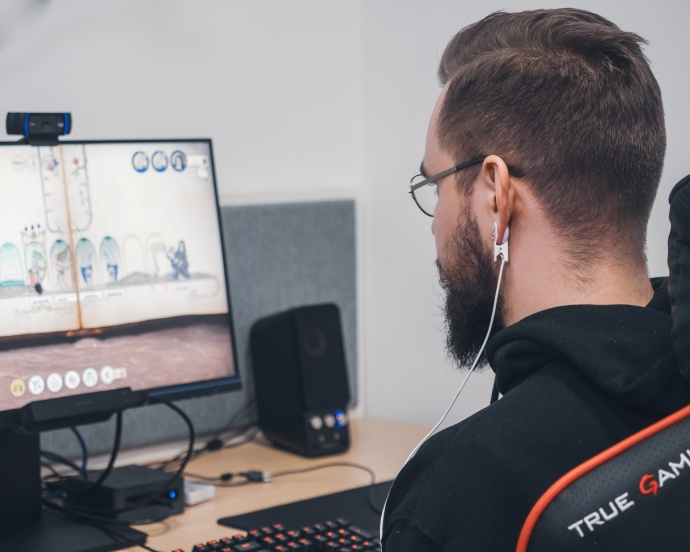
Pupillometry
Pupillometry involves measuring changes in pupil size—how the pupil dilates or constricts. Pupil size varies in response to both visual and non-visual stimuli. While changes in light levels naturally cause the pupil to expand or shrink, cognitive effort, emotional arousal, and task involvement also play a role.
Therefore, interpreting pupillometry data requires careful attention to potential influencing factors.
Elements of game design, such as lighting changes, color shifts, or screen transitions, can affect pupil size on their own. This makes it essential to include controls or adjustments in experiments. This helps separate reflexive reactions to visual stimuli from those caused by cognitive or emotional factors.
Pupillometry stands out in the field of psychophysiology because it’s non-invasive and works well with eye-tracking technology. This means researchers can study both pupil changes and where players are looking at the same time, giving a more complete picture of the gaming experience. To make their findings even more insightful, researchers often combine pupillometry with other physiological measures like heart rate variability or electrodermal activity. By using this multimodal approach, they can better understand the mix of cognitive and emotional factors players experience. Pairing these methods can help clarify the cause of pupil dilation. It can reveal whether it is due to mental effort, emotional excitement, or both. This provides a richer and more detailed understanding of player engagement.
Pupil Dilation
Pupil dilation is a marker of emotional arousal, occurring whether the stimulus is positive or negative. Studies show that emotionally charged situations, such as high-stakes scenarios or dramatic narrative moments, cause significant pupil dilation. This occurs due to the activation of the sympathetic nervous system. This makes pupillometry an effective tool for assessing emotional engagement in real time. It provides insights into players’ reactions to intense or emotionally impactful game content. For example, in first-person shooter games, researchers have linked pupil responses with other physiological signals, like heart rate. Such multipodal approach helped to assess excitement and stress levels during gameplay.
In addition to emotional arousal, pupil dilation suggests cognitive load and task engagement. Increased pupil size has been shown to correlate with the cognitive demands of a task, reflecting the amount of mental effort a player is investing.
During gameplay that involves significant decision-making or problem-solving, players may show larger pupil diameters. Such dilation occurs as they engage with complex stimuli or navigate challenging scenarios. Therefore, research proves that players’ pupillary responses can effectively classify difficulty levels in educational video games.
Pupil Constriction
Electrodermal Activity (EDA), Galvanic Skin Response (GSR)
Another measure of emotional arousal is electrodermal activity (EDA), commonly referred to as galvanic skin response (GSR). EDA reflects changes in the skin’s electrical conductivity. This is influenced by sweat gland activity, which is controlled by the sympathetic nervous system. Unlike other sweat glands, whose primary function is to moderate body temperature, these respond principally to psychological stimulation. They are primarily located in the palms of the hands and soles of the feet. However, they are also present on the shoulders, wrists, forehead, and neck.
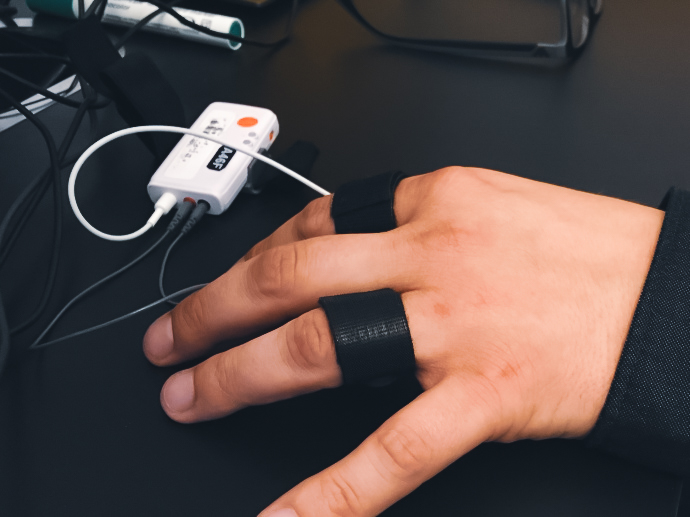
What EDA Can Tell You
EDA is one of the most well-established measures of emotional arousal and is widely used in psychophysiology.
EDA can act as a real-time indicator of stress and workload, as changes in EDA suggest both stress and cognitive load. This feature is particularly useful for identifying moments of high stress or cognitive overload. It provides valuable insights for game design and strategies to better support players.
Studies have found that EDA, along with respiratory activity, positively correlates with gamers’ self-reported levels of mental demand and frustration. . This makes it an effective method for capturing emotional states during gaming. In fact, researchers have suggested using EDA to distinguish between casual and hardcore gamers. Different levels of emotional arousal may indicate varying types of gaming engagement.
EDA’s Shortcomings in Psychophysiology
While EDA is known for its reliability and accuracy, it is important to consider its delayed response to a stimulus. There is a recovery period afterward during which no further reactions are detected. Additionally, since EDA is typically measured through electrodes attached to the hands, players’ movements while using a game controller can sometimes interfere with the signal. However, researchers have successfully explored alternative electrode placement sites and attachment methods to address this issue.
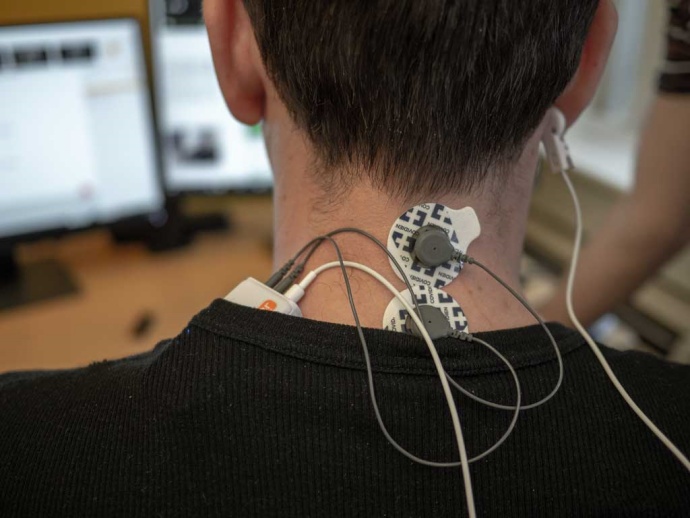
Electroencephalography (EEG)
EEG measures electrical activity in the brain using electrodes placed on the scalp, providing insight into the cognitive and emotional states of gamers during gameplay. This technique tracks various brainwave patterns linked to mental states like attention, cognitive load, and emotional responses.
How does it work? In simple terms, brain activity is measured using two key factors: amplitude (how strong the signal is) and frequency (how fast the signal cycles). These measurements help identify different brainwave patterns, such as delta, theta, alpha, beta, and gamma. Each of these patterns, or bands, relates to specific cognitive, emotional, or attentional processes.
What EEG Can Tell You
Cognitive Control
Research has shown that certain EEG band frequencies, especially theta waves, are linked to cognitive control and improved performance in e-gamers. Higher theta power has been associated with better cognitive function, therefore EEG be used to effectively track cognitive engagement during gaming. Similarly, greater modulation of alpha power in the EEG has been linked to faster visual information processing in video gamers.
Flow State
The concept of “flow,” a state of deep immersion and enjoyment during gameplay, has also been studied using EEG. To better understand this state, researchers created a method that combines EEG recordings with behavioral data to assess flow indirectly. Therefore, by analyzing brain activity alongside players’ actions, it is possible to measure how focused players are during gaming.
Emotional State
EEG can also effectively help assess emotional states and stress levels in gamers. In one study, an EEG machine recorded brain activity through multiple channels. This enabled researchers to differentiate between four basic emotions—happiness, calmness, fear, and sadness—during gameplay. The results showed that players felt positive emotions like calm and happiness at the start and end of the game, likely due to the lack of pressure at the beginning and a sense of relief at the end. However, as the game progressed, players began to experience more negative emotions, probably due to the increased stress of advancing through higher levels.
Approach/Withdrawal Tendencies
Additionally, EEG can reveal approach or withdrawal-related tendencies in behavior and emotions by measuring the frontal asymmetry index. Research has shown that increased activity in the left frontal brain occurs next to a tendency to approach a stimulus, while greater activation of the right frontal brain suggests a tendency to withdraw from a stimulus.
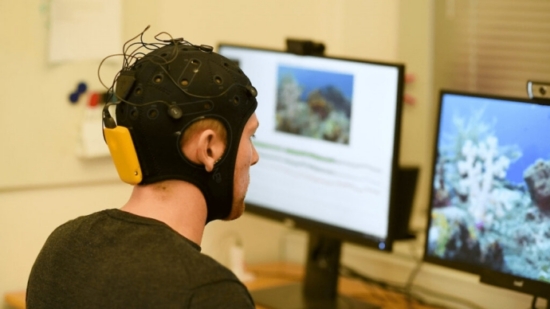
EEG’s Shortcomings in Psychophysiology
Like other methods, EEG has drawbacks that psychophysiology researchers must consider. Typically, researchers use an EEG cap or headset with wet electrodes to simplify electrode placement and reduce motion artifacts. However, the use of wet electrodes can affect players’ comfort, especially due to the discomfort of having wet hair. Additionally, EEG measurements are sensitive to artifacts caused by head movement, making them less suitable for studying active games or extended gameplay sessions.
Eye Tracking
Eye tracking is a method of monitoring eye movement and gaze. It helps understand where and for how long a player looks, as well as how their eyes move across the screen. While it provides valuable insight into a player’s visual attention, tracking gaze alone doesn’t reveal much about the cognitive processes or emotional states behind those eye movements. To gain a deeper understanding, combining eye tracking with other data sources can be highly beneficial. Methods in psychophysiology, as mentioned earlier, can complement this approach.
We only mention this method briefly as one more psychophysiological tool, though it doesn’t directly measure arousal. We have covered eye tracking in more detail in another article, here.
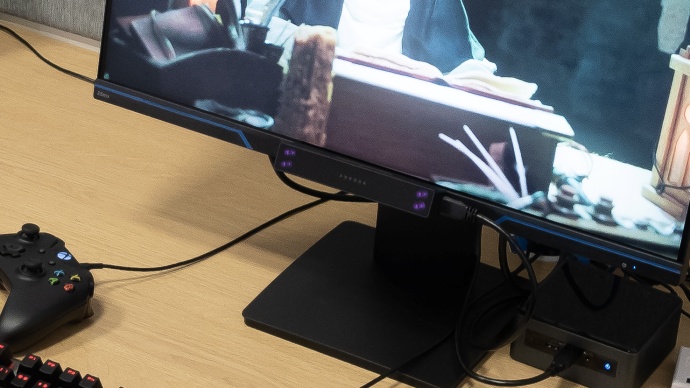
Psychophysiology in Practice – Real-Life Applications
Psychophysiology in Try Evidence’s Lab
Study 1
In our lab, we have successfully used various psychophysiological measures to explore players’ experiences in greater detail. Evaluating trailers is one of many ways to utilize such methods in game research. In one of our studies, we compared two trailers for upcoming games, Senua’s Saga: Hellblade II (Ninja Theory) and Godfall (Counterplay Games), to see which one was more emotionally arousing and engaging for players. By combining EDA (GSR) with eye tracking, we identified patterns of emotional arousal, pinpointed scenes that triggered emotional responses, and tracked where players focused their gazes. In addition, we expanded our understanding by using a survey to gather more information. The survey gave us insights into how appealing the trailer was to the audience and how likely they were to play the game after watching it.
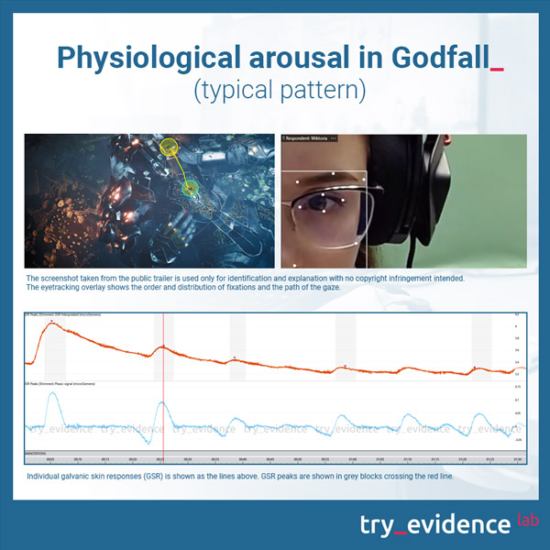
Study 2
In another study, we focused on the attractiveness of video game characters to players. By measuring EDA, we identified which heroes and heroines triggered a high level of arousal in players.
Here’s a spoiler: not surprisingly, Geralt of Rivia from The Witcher 3: Wild Hunt (CD Project Red) was the most stimulating male character. We were able to hypothesize potential sources of emotional arousal based on the elements that captured players’ attention, as shown through eye tracking. This demonstrates psychophysiological methods’ application in evaluating character design.
To see how players reacted to other characters, like:
- Ezio (Assassin’s Creed, Ubisoft Montréal),
- Lucian (League of Legends, Riot Games),
- Joel (The Last of Us, Naughty Dog),
- Kokoro (Dead or Alive 6, Ninja Theory),
- Lara Croft (Shadow of the Tomb Raider, Eidos-Montréal),
- Agent 47 (Hitman series, IO Interactive),
check out the full article here, where we cover even more game characters.
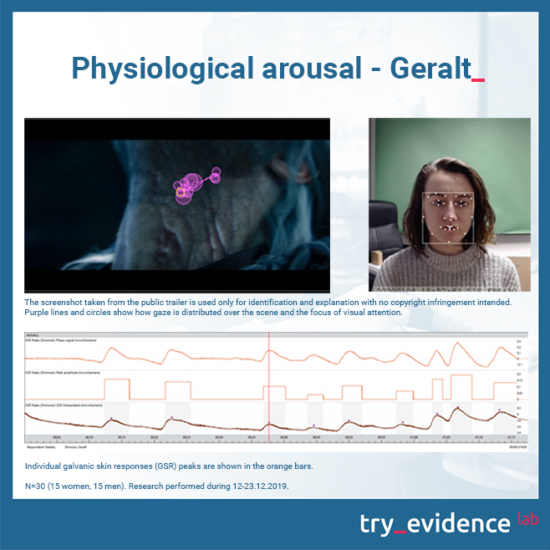
Psychophysiology in Game Developers’ Labs
Far Cry 4
Pierre Chalfoun and Jonathan Dankoff conducted a study at Ubisoft’s user research lab on the Far Cry 4 (Ubisoft Montréal) demo trailer. Their work focused on identifying the most emotionally engaging moments in the trailer, assessing its attractiveness, and evaluating players’ understanding of the introduced features. By combining EDA with self-report measures, they discovered that they needed to properly introduce and highlight the co-op feature to enhance its impact.
They used their findings to refine the trailer through an iterative process, using feedback from each study to modify it before the next test.
You can read more about that in the 17th Chapter of Games User Research book (P. Mirza-Babaei A. Drachen and L. Nacke).
Resident Evil 3
Psychophysiological methods can also be applied on a larger scale, as shown in Macromill’s study of Capcom’s Resident Evil 3. The team used heart rate and EDA as indicators of excitement and vigilance to better understand how players responded to the game’s core themes (survival & horror).
The researchers divided the game into 12 chapters and analyzed the average heart rate and EDA for each one. This approach allowed them to identify which chapters triggered intense fear and panic in players and which failed to deliver the intended experience. For instance, they found that one chapter, where a group of zombies chased a character, was less scary than expected. Additionally, they discovered that fear heightened players’ vigilance. These insights led Capcom to reconsider how people experience fear and confront it, prompting a return to the fundamental question of what makes horror effective.
Psychophysiology in Researching Horror Trailers
Another interesting example of applying psychophysiological methods in assessing trailers comes from studying horror movie trailers. The team at iMotions conducted a small study to determine which of the three trailers was the scariest. They combined eye tracking, EDA, EEG (frontal asymmetry), and self-reports to assess visual attention, emotional arousal, approach vs. avoidance motivation, and each trailer’s likeability and scariness, respectively.
They found that the scariest trailer, as rated by the viewers, was also the most emotionally arousing. Moreover, it elicited the highest behavioral approach motivation,
which may seem counterintuitive as we expect people to be more likely to avoid fear-inducing situations.
However, it’s essential to keep in mind that EEG can’t tell us what is causing this motivation. The trailer itself, the context in which it’s being watched, the viewer’s thoughts and feelings towards the trailer, or a combination of all these factors could trigger it. Nevertheless, by analyzing these findings in the context of a movie trailer’s purpose, the researchers hypothesized that viewers felt interested in seeing the movie in the cinema, which led to the approach motivation. They confirmed this hypothesis through additional data from viewers’ self-reports.
Takeaways
Emotions play a key role in player experience, influencing both behavior and game sales. Leading voices in Game User Research agree that combining traditional methods with psychophysiology offers a gateway toward a better understanding of players’ behavior and experience. By accessing human emotions at a more basic, unconscious level, we can gain more accurate insights, which better inform design decisions.
The growing availability of physiological sensors has made psychophysiological research more accessible, expanding its use from academic settings to commercial ones. These sensors have become more affordable and easier to use outside of clinical environments. Research software like iMotions, which we use in our lab, has further streamlined psychophysiological analysis, making it faster and more convenient. However, fully automated AI-powered emotion detection models are still not widely available.
In our research, we apply our understanding of human psychology and its connection to physiology to infer players’ emotions based on body signals.
This approach helps reduce bias and dependence on factors like memory, self-esteem, and honesty, which can affect self-reports.
Psychophysiological measures, such as changes in skin conductance, muscle activity, brainwaves, and heart rate, provide reliable and unbiased data. They can be recorded in real time with minimal impact on the player’s natural behavior. The most commonly used measures in Game User Research are electrodermal activity and, to a lesser extent, cardiac activity.
Disclaimer
There is no surefire way to guarantee that your game, teaser, trailer, or gameplay movie will resonate with the crowd. Case studies demonstrate that Games User Research labs, such as Try Evidence’s facility, have effectively employed psychophysiological methods to provide a competitive advantage to design and marketing teams. These insights have enabled developers to prioritize and improve aspects key to player experience while ensuring that they deliver emotionally engaging and memorable experiences, without compromising on their original goals.
If you want to know which method best suits your game and goals, don’t hesitate to contact us.






